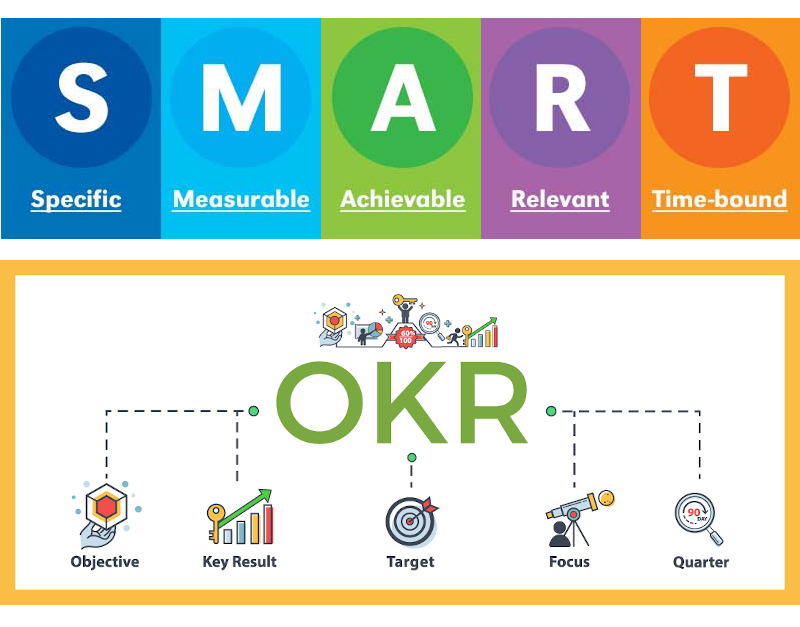
Learn how to write SMART goals and the Objectives and Key Results (OKR) method of setting objectives from the book Measure What Matters.
As we approach the end of the year, it is a great time to review best practices for setting new objectives.
This post will cover:
- how to write SMART goals,
- the Objectives and Key Results (OKR) method of management,
- tips from the book Measure What Matters,
- how OKRs and KPIs are related,
- and setting objectives for personal kaizen.
We also have a special BONUS OFFER at the end of the post. Connect with us to learn Google’s 5 OKR traps to avoid.
SMART Goals
We always recommend individuals and organizations set SMART goals. SMART is an acronym that stands for:
S = Specific. Be precise in the action you are taking. A goal of “increase profit” could be achieved in many ways. What specific action(s) will you take? A better objective is to “increase profit by completing three new service contracts.”
M = Measurable. Every specific action should have a measure of success. For example, “increase profit by 20% over the previous year from completing three new service contracts.”
A = Achievable and Action-Oriented. Be sure your goal or objective is something you are doing – an action – and not just an outcome you hope to achieve. You must also be able to identify a path to success. Setting stretch goals are great, but impossible goals only serve to create a culture of failure in your company — this is far from the motivational environment you’re looking to cultivate.
R = Relevant. Ensure your objective is within your scope of control and fits into the overall goals of the organization.
T = Time-Bound. Agree on set target dates for when objectives are to be completed. For example, “increase profit by 20% over the previous year from completing three new service contracts before the end of the first quarter.”
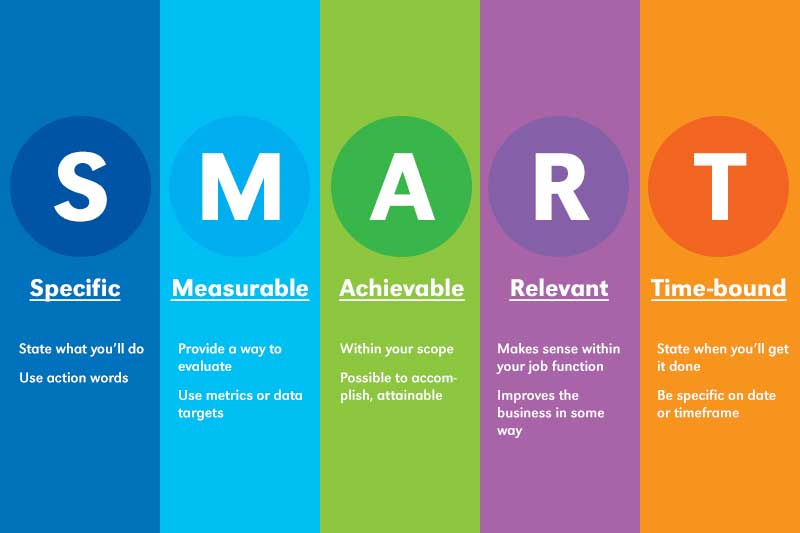
Setting objectives using SMART goals is the bare minimum approach, so the OKR approach expands upon this idea into a method for management by objective (MBO).
Setting Objectives and Key Results (OKRs)
Legendary venture capitalist John Doerr wrote the New York Times bestseller Measure What Matters about using an Objectives and Key Results (OKR) approach to operational excellence. Doerr worked as an engineer at Intel under Andy Grove (who Doerr called “the greatest manager of his or any era”) where he learned to use OKRs. He later introduced OKRs to over 500 companies where he was an investor, including Google, Amazon, Intuit, and Twitter.
OKRs help ensure that the entire organization focuses its efforts on the same important issues. Objectives are the WHAT – they are significant, concrete, action-oriented, and (ideally) inspirational. Key Results are the HOW – they are specific and time-bound, aggressive yet realistic. A best practice is to define three measurable Key Results for each Objective.
Measure What Matters
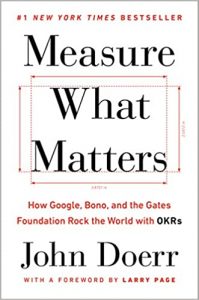 Doerr’s book describes four “superpowers” that OKRs will enable in your organization and describes an approach to continuous performance management that replaces the annual performance review.
Doerr’s book describes four “superpowers” that OKRs will enable in your organization and describes an approach to continuous performance management that replaces the annual performance review.
The four superpowers are:
- Focus and commit to priorities: What are the 3-4 most important initiatives for the next 3-6 months? Where must we concentrate our efforts?
- Align and connect for teamwork: Combine cascading OKRs (from top to bottom) with “Bottoms Up” OKRs set by individual employees. Share all organizational OKRs for transparency and alignment.
- Track for accountability: OKRs are tracked and reviewed regularly during the period and scored at the end of the period. A score of 70% and above is good!
- Stretch for amazing: OKRs should have both committed objectives and aspirational (stretch) objectives. Include BHAGs in your OKRs!
Here are some other tips about using the Objectives and Key Results management method from Doerr and the many successful companies that use OKRs:
- You should have 3-4 Objectives per quarter, with 3-4 Key Results for each Objective.
- OKRs can (and should) change during the quarter
- Key results must be measurable and have a number
- Objectives should be inspirational and feel slightly uncomfortable
- Ideally, you only achieve 70% of your OKRs – getting 100% means your OKRs aren’t ambitious enough
- Low grades are not to be punished
Cascading OKR Example
One of Doerr’s examples of a cascading set of OKRs is based on a fictitious professional football team. Note here how the OKRs for the General Manager come from the Owner and cascade down to the rest of the organization.
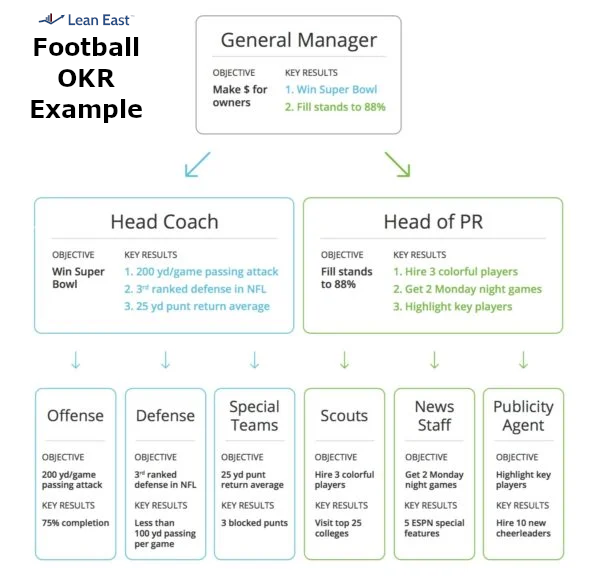
I believe this example has numerous problems, including an uninspiring objective (to make money) and poor linkage of OKRs between leaders. It does demonstrate how objectives cascade; if each individual area achieves their OKRs it is likely the overall OKRs will be met.
Google uses OKRs throughout the organization and has realized better results when employees also set their own stretch OKRs. They recommend organizations combine cascading “top-down” OKRs with employee written stretch goals. I have done this in the past and agree with combining team and personal objectives when setting employee expectations for the period.
Key Performance Indicators (KPIs) versus OKRs
Lean East has written previously about using a balanced scorecard of KPIs to assess performance. You may be wondering: how do KPIs differ from OKRs?
KPIs represent key operational indicators that an organization believes reflect performance. While your key performance indicators should be important, they are measures and not objectives. For example, a KPI of “time to process a claim” can be tracked and shared.
OKRs include an improvement and measures of success. An employee might set an objective to improve customer satisfaction by 20% during the 1st quarter of the year. One key result that is identified and measured to show success at this objective could be “time to process a claim” decreasing by 25% during the quarter. Here, the existing KPI has an improvement objective for the quarter.
Organizations with established KPIs should find it easy to begin managing by objective using an OKR approach. Don’t forget to focus – you should only have 3-4 OKRs to focus on at any one time!
Personal Kaizen: Setting Objectives
The examples in this post are all about organizational objectives, but the lessons apply to setting personal objectives as well. Setting your improvement objective(s) is an early step in Personal Kaizen. In what areas of your life do you want to improve? Why? What are the key results you are targeting?
We hope this post helps you understand how to set SMART, measurable objectives. We still have an important area to cover in a future post: how to live your life. Please subscribe to our newsletter so you don’t miss this perspective!
Bonus Offer
No one has more collective experience implementing OKRs than Google. As a special bonus offer, we will send you six traps to avoid when using OKRs and an update on how Google has adapted OKRs under new leadership (Alphabet is now the parent company of Google).
Please go to our contact form, fill in your information, and write, “OKR Traps” in the message area. We will email you these additional insights before the end of the year.
Please share your comments about setting objectives, SMART goals and OKR methods below. Let us know about the method your organization uses to sets its goals and if it works for your team.

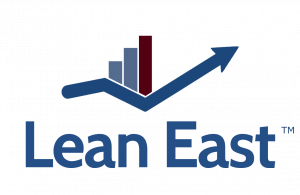
Related Posts
How I am Changing the Career Advice I Give My Kids
This is Never Going to Work: Getting Lean Projects Unstuck
How to Speak so that People Want to Listen